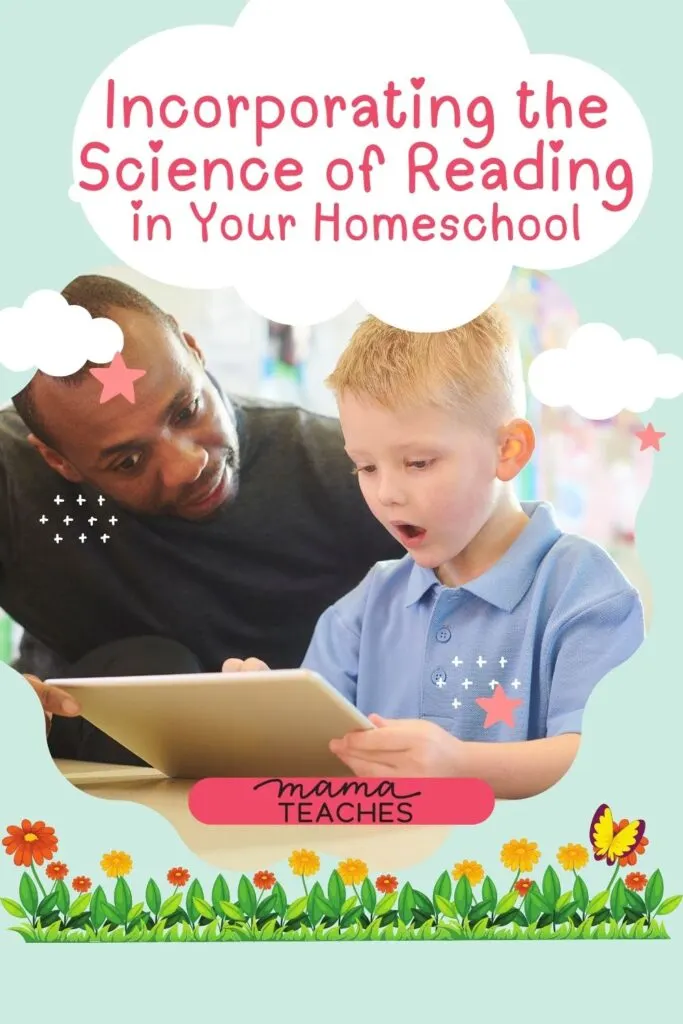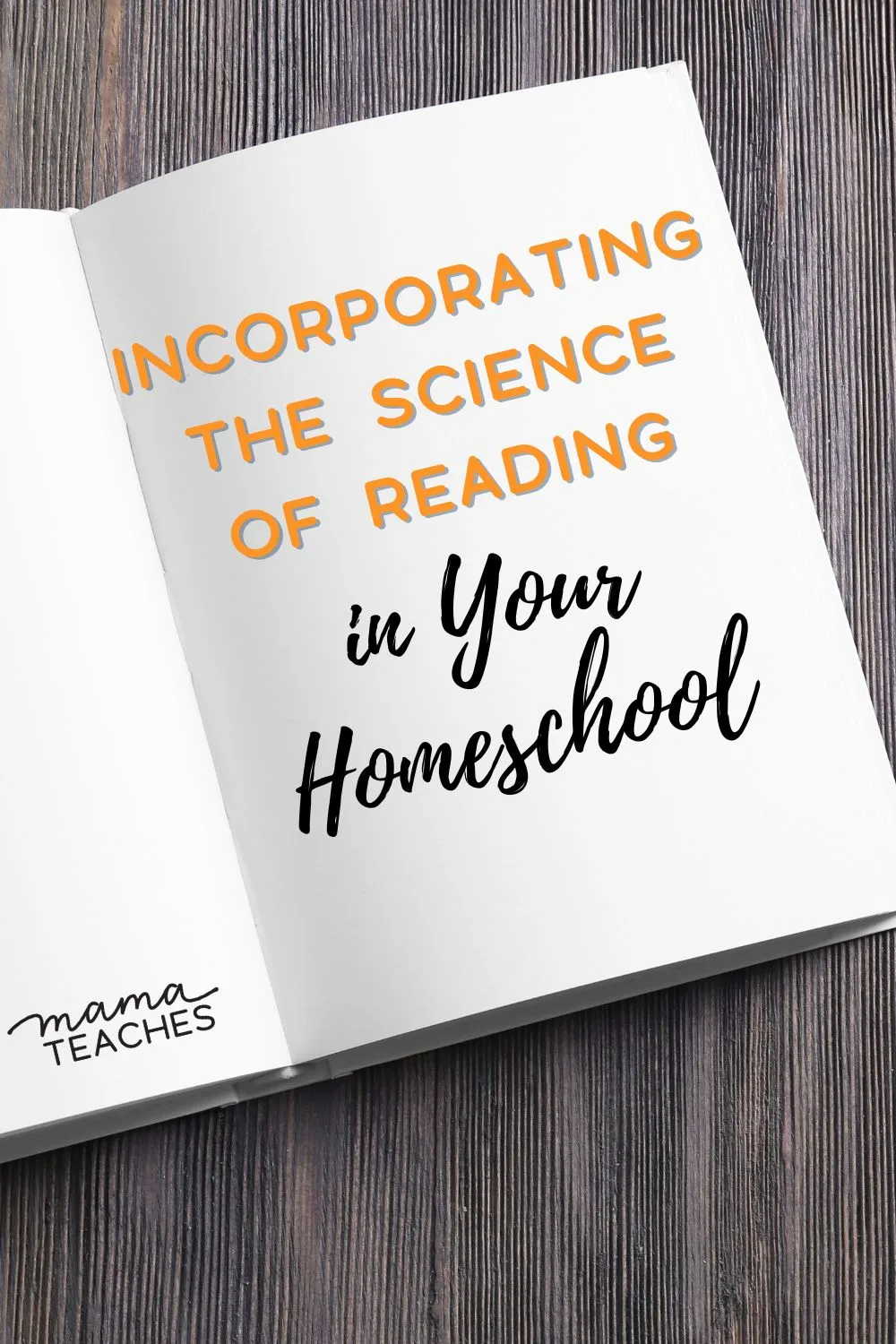Classroom teachers across the country are teaching Science of Reading. Can it work in a homeschool setting? You bet!

What Is the Science of Reading?
The Science of Reading (SoR) summarizes scientific research on teaching reading rather than prescribing a specific approach.
It concludes that developing specific skills in five areas is the most effective way to teach reading.
To become a proficient reader, a student needs phonemic awareness, phonics instruction, fluency exercises, vocabulary building, and reading comprehension.
For more on the Science of Reading, check out this article.
Teaching Science of Reading in Homeschool
You can incorporate the recommended strategies from the Science of Reading into your homeschool reading lessons. Even if your 10 year old can’t read well, these strategies and ideas will still work well!
Phonemic Awareness
All words are made up of basic sounds called phonemes.
Before a child can learn to read, he needs to hear, separate, and manipulate the sounds in words.
Before formal reading instruction, teach your child phonemic awareness through play.
Here are some ideas:
- Play with rhyming words
- Teach the letter names through play with foam letters, letter magnets, or sandpaper letters
- Use chants, pictures, and activities to teach the letter sounds
- Teach kids to recognize syllables by clapping their way through a word
- Link letters to their beginning sounds in words

This article contains affiliate links to things that you might like.
Phonics Instruction
The Science of Reading is clear. Do not teach reading by sight words or through a blended approach.
Teach your child to read with systematic and explicit phonics instruction.
Only teach actual sight words that are not decodable (like of, people, and said).
To get started, check out these articles on teaching reading:
- How to Teach CVC Words
- Teaching Vowels and Consonants
- How to Teach Vowels
- How to Teach Blending Sounds
If you are looking for a homeschool phonics program, try one of these suggestions that will work with all types of homeschooling methods:
- The Ordinary Parent’s Guide to Teaching Reading
- Phonics Pathways
- Teach Your Child to Read in 100 Easy Lessons

Fluency Exercises
Fluency is a skill that progresses in stages, from emergent reader to novice reader to decoding reader and finally fluent reader.
A fluent reader reads a text smoothly and with expression, fully comprehending the content and ideas.
Fluency takes training. Teaching Science of Reading in your homeschool means practicing fluency exercises.
At the emergent stage, this simply means reading aloud to your child. Don’t ever stop doing this! Read aloud for twenty minutes a day.
Your novice reader will need to decode a sentence, listen to you repeat the sentence back to him, and then read/recite the sentence back to you.
A decoding reader (and a reader working toward complete fluency) needs to practice fluency with passages of text.
Step 1: Choose a language-rich selection. This should be a high-quality text (not an easy reader or graphic novels).
Step 2: Read the passage (or poem) aloud to the child
Step 3: The child reads the passage back to you multiple times, focusing on correct pronunciation, expression, and pacing.

Vocabulary Building
Having a sizeable working vocabulary helps students to become able readers.
You can promote vocabulary building in your homeschool through two tactics.
The first is to read aloud to your child (or have him listen to audiobooks). Children can understand books far above their reading level.
Read aloud to your child even after they have learned to read; read chapter books, nonfiction books, and classics.
The second tactic is to work vocabulary practice into your homeschool reading lesson.
You can teach target words for the week that are incidental to the child’s reading.
Or you can use a formal vocabulary program.
Learning vocabulary does not have to be dull; check out these ways to make it fun!

Reading Comprehension
If you are teaching Science of Reading with the above strategies, reading comprehension will naturally develop.
The Science of Reading uses this formula: RC = D x LC.
This means that reading comprehension (RC) is the product of decoding (D) and language comprehension (LC).
Decoding skills happen through systematic and explicit phonics instruction.
Language comprehension evolves more slowly.
If you have worked with a novice, struggling, or beginning decoding reader, you are familiar with the following scenario.
You have a sentence before you. The child struggles but successfully decodes the sentence.
You ask, “What was that sentence about?” And they can’t say.
While you may despair, this is quite normal and part of learning to read.
Fluency exercises (where you read the sentence back to the child, and then he reads it to you) and vocabulary building pave the way for language comprehension.
You can further enhance reading comprehension by using guided reading instruction and identifying the main idea of a book or passage.

How to Incorporate the Science of Reading into Homeschool
The conclusions and practical applications of the Science of Reading should not be isolated to the traditional classroom.
As a homeschooling parent, you can provide personalized reading instruction that aligns perfectly with the Science of Reading.
Your child will soon become a fluent reader if you incorporate these activities and exercises that focus on the five areas of reading instruction.
That’s now backed up by science!
